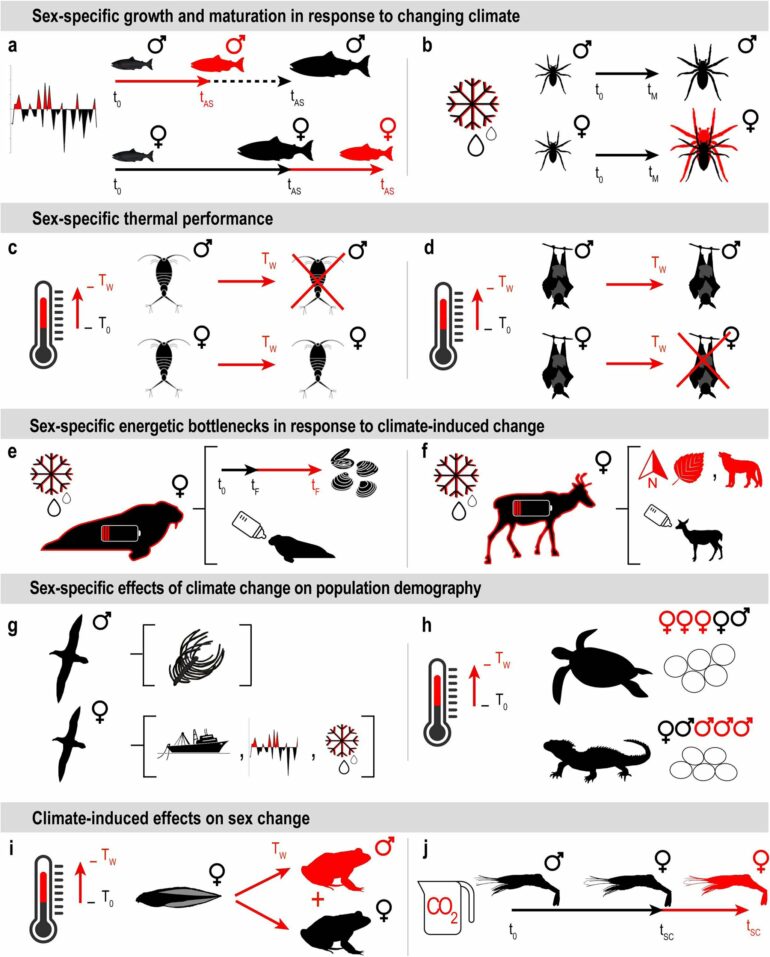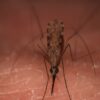Biological sex can be an important factor in predicting how animal and plant populations respond to temperature changes, from sea turtles whose sex is determined by the heat on the beach where they hatch, to female Arctic caribou that migrate through predator territory in years of earlier snowmelt to replenish their energy reserves for nursing young.
Yet few environmental studies and even fewer conservation plans take these differences into account, according to research published in Nature Communications.
“Studying sex-specific responses to climate hazards like heat waves and extreme temperature fluctuations is critical for slowing biodiversity loss,” said lead study author Elena Gissi, a Marie Sklodowska Curie Fellow based in the Oceans Department at the Stanford Doerr School of Sustainability.
Distinguishing between sex and gender
Sex refers to the biological characteristics of living organisms affecting physiology and physical appearance, whereas gender refers to sociocultural norms, identities, and relations that structure societies and organizations, and shape behaviors, technologies, environments, and knowledge.
Co-author Londa Schiebinger, a professor of the history of science in the School of Humanities and Sciences, has devoted her career to understanding the gendering of human knowledge, including how to reduce bias in artificial intelligence and medical research. “As we’ve seen in other fields, incorporating sex analysis into the environmental sciences can lead to new discoveries about the natural world—both its resilience and its vulnerability in face of the ever increasing climate catastrophe,” Schiebinger said.
For several populations of the black-vented shearwater, a coastal seabird that nests along Baja California, Mexico, a 2014 marine heat wave led to behavioral differences between males and females. A large mass of warm water known as “The Blob” upended ocean food webs and prompted male and female shearwaters, which typically forage in the same area, to avoid competition with one another by feeding separately. Males flew north and females flew south.
This observation matters for conservation managers in Baja. For example, a marine protected area could unintentionally protect the foraging grounds of only one sex of the near-threatened seabird during warmer years, with cascading impacts on the overall population.
“One million species are at risk of extinction due to human impacts, jeopardizing the natural world that makes our life possible and beautiful,” said global change biologist Elizabeth Hadly, a co-author of the study and professor of biology in the School of Humanities and Sciences. “By considering biological sex in climate change studies, we can better predict what’s to come and better protect marine and terrestrial species.”
Varying responses
In polar regions, where global warming impacts are most extreme, years with earlier snowmelt can be a boon for Arctic wolf spiders. An earlier spring kick-starts the growing season. Given the extra time to mature, both sexes grow larger, with females increasing in size even more than males, improving their odds of getting and staying pregnant and their ability to nourish their offspring. For female caribou, on the other hand, which bulk up in the spring to care for their young, accelerated snow melt forces them to migrate north as springtime warms the pole. Their search for greening vegetation is often rewarded by nutritious food, but the journey exposes them to predators like wolves that roam the higher latitudes.
In the Southern Hemisphere, hotter sands in Australia threaten the survival of six sea turtle species that nest on the beaches. The environment determines a sea turtle’s sex. For the loggerhead species, if the sand incubates the eggs at around 29°C (84°F), hatchlings will be female. Below that temperature, males hatch.
“In order for sea turtle populations to survive into the future, they need to have an appropriate ratio of males to females,” said co-author Larry Crowder, a marine ecologist and professor of oceans. “If we overlook the different vulnerabilities of each sex to rising global temperatures, we risk losing thirty years of conservation efforts within one generation of sea turtles.”
Incorporating biological sex
In many cases, researchers don’t gather sex-specific data simply because it’s logistically difficult, said Gissi. Among some bird species like blue jays and mourning doves, males and females can be difficult to distinguish by appearance alone. Other researchers may lack awareness that these data are relevant for study results or policy outcomes, she said.
But change is afoot. In an effort to produce more male hatchlings, the Queensland Government’s sea turtle conservation strategy, published in 2021, prioritized tactics like shading nests and relocating eggs to cooler locations. Gissi also pointed to steps being taken by funding agencies and scientific journals. In 2022, the National Science Foundation hosted workshops on how best to integrate sex analysis into their funding guidelines, the same year that the journal Nature announced guidelines that require authors to state how they included or excluded sex in their study design, and to clarify why.
“Potentially, biological sex has something to do with every experiment involving living organisms,” said Gissi. “Including sex analysis in research design should become the default. To enhance the rigor and reproducibility of science, it’s valuable to report when sex plays an important role and also to report null results, when sex is not a determining factor. If we want to safeguard the future of life on Earth, we need to assess what role sex plays in our rapidly changing world.”
Taking action to reverse biodiversity loss
Scientists, funding agencies, and policymakers, particularly those working in conservation, can all play a role in enabling sex-specific science when considering how species respond to climate change. The study authors recommend the following:
For scientists:
Study the relative contribution of sex and climate drivers in organisms’ response to climate changeExamine how sex-specific responses to climate change at an individual level will affect species populations and communitiesIncorporate analysis of biological sex into lab and field experiments
For funding agencies:
Support basic research on sex-specific responses to climate change
For policymakers:
Consider sex-specific responses of species to climate stressors before designating new protected areas, and coordinate management and monitoring based on sex-specific knowledge for climate adaptation and mitigation
More information:
Elena Gissi et al, Exploring climate-induced sex-based differences in aquatic and terrestrial ecosystems to mitigate biodiversity loss, Nature Communications (2023). DOI: 10.1038/s41467-023-40316-8
Provided by
Stanford University
Citation:
Climate change’s impacts on wildlife can vary by sex (2023, October 27)



